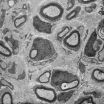(Press-News.org) In what is believed to be the first study of its kind, researchers used genomic techniques to document the presence of significant numbers of living microorganisms – principally bacteria – in the middle and upper troposphere, that section of the atmosphere approximately four to six miles above the Earth's surface.
Whether the microorganisms routinely inhabit this portion of the atmosphere – perhaps living on carbon compounds also found there – or whether they were simply lofted there from the Earth's surface isn't yet known. The finding is of interest to atmospheric scientists, because the microorganisms could play a role in forming ice that may impact weather and climate. Long-distance transport of the bacteria could also be of interest for disease transmission models.
The microorganisms were documented in air samples taken as part of NASA's Genesis and Rapid Intensification Processes (GRIP) program to study low- and high-altitude air masses associated with tropical storms. The sampling was done from a DC-8 aircraft over both land and ocean, including the Caribbean Sea and portions of the Atlantic Ocean. The sampling took place before, during and after two major tropical hurricanes – Earl and Karl – in 2010.
The research, which has been supported by NASA and the National Science Foundation, was scheduled to be published online January 28th by the journal Proceedings of the National Academy of Sciences.
"We did not expect to find so many microorganisms in the troposphere, which is considered a difficult environment for life," said Kostas Konstantinidis, an assistant professor in the School of Civil and Environmental Engineering at the Georgia Institute of Technology. "There seems to be quite a diversity of species, but not all bacteria make it into the upper troposphere."
Aboard the aircraft, a filter system designed by the research team collected particles – including the microorganisms – from outside air entering the aircraft's sampling probes. The filters were analyzed using genomic techniques including polymerase chain reaction (PCR) and gene sequencing, which allowed the researchers to detect the microorganisms and estimate their quantities without using conventional cell-culture techniques.
When the air masses studied originated over the ocean, the sampling found mostly marine bacteria. Air masses that originated over land had mostly terrestrial bacteria. The researchers also saw strong evidence that the hurricanes had a significant impact on the distribution and dynamics of microorganism populations.
The study showed that viable bacterial cells represented, on average, around 20 percent of the total particles detected in the size range of 0.25 to 1 microns in diameter. By at least one order of magnitude, bacteria outnumbered fungi in the samples, and the researchers detected 17 different bacteria taxa – including some that are capable of metabolizing the carbon compounds that are ubiquitous in the atmosphere – such as oxalic acid.
The microorganisms could have a previously-unidentified impact on cloud formation by supplementing (or replacing) the abiotic particles that normally serve as nuclei for forming ice crystals, said Athanasios Nenes, a professor in the Georgia Tech School of Earth and Atmospheric Sciences and School of Chemical and Biomolecular Engineering.
"In the absence of dust or other materials that could provide a good nucleus for ice formation, just having a small number of these microorganisms around could facilitate the formation of ice at these altitudes and attract surrounding moisture," Nenes said. "If they are the right size for forming ice, they could affect the clouds around them."
The microorganisms likely reach the troposphere through the same processes that launch dust and sea salt skyward. "When sea spray is generated, it can carry bacteria because there are a lot of bacteria and organic materials on the surface of the ocean," Nenes said.
The research brought together microbiologists, atmospheric modelers and environmental researchers using the latest technologies for studying DNA. For the future, the researchers would like to know if certain types of bacteria are more suited than others for surviving at these altitudes. The researchers also want to understand the role played by the microorganisms – and determine whether or not they are carrying on metabolic functions in the troposphere.
"For these organisms, perhaps, the conditions may not be that harsh," said Konstantinidis. "I wouldn't be surprised if there is active life and growth in clouds, but this is something we cannot say for sure now."
Other researchers have gathered biological samples from atop mountains or from snow samples, but gathering biological material from a jet aircraft required a novel experimental setup. The researchers also had to optimize protocols for extracting DNA from levels of biomass far lower than what they typically study in soils or lakes.
"We have demonstrated that our technique works, and that we can get some interesting information," Nenes said. "A big fraction of the atmospheric particles that traditionally would have been expected to be dust or sea salt may actually be bacteria. At this point we are just seeing what's up there, so this is just the beginning of what we hope to do."
INFORMATION:
The Georgia Tech team also included Natasha DeLeon-Rodriguez and Luis-Miguel Rodriguez-R from the Georgia Tech School of Biology, Terry Lathem from the Georgia Tech School of Earth and Atmospheric Sciences, and James Barazesh and Michael Bergin from the Georgia Tech School of Civil and Environmental Engineering. The Georgia Tech team received assistance from researchers Bruce Anderson, Andreas Beyersdorf, and Luke Ziemba with the Chemistry and Dynamics Branch/Science Directorate at the NASA Langley Research Center in Hampton, Va.
This research was supported, in part, by NASA grant number NNX10AM63G, by a GAANN Fellowship from the U.S. Department of Education, a NASA-NESSF fellowship, and by a National Science Foundation graduate research fellowship. The opinions expressed are those of the authors and do not necessarily represent the official views of NASA, the Department of Education or the NSF.
Study finds significant microorganism populations in middle and upper troposphere
Bugs in the Atmosphere
2013-01-29
ELSE PRESS RELEASES FROM THIS DATE:
New research uncovers the neural mechanism underlying drug cravings
2013-01-29
Addiction may result from abnormal brain circuitry in the frontal cortex, the part of the brain that controls decision-making. Researchers from the RIKEN Center for Molecular Imaging Science in Japan collaborating with colleagues from the Montreal Neurological Institute of McGill University in Canada report today that the lateral and orbital regions of the frontal cortex interact during the response to a drug-related cue and that aberrant interaction between the two frontal regions may underlie addiction. Their results are published today in the journal Proceedings of ...
Hospital patient loads often at unsafe levels, physician survey says
2013-01-29
Nationwide, more than one-quarter of hospital-based general practitioners who take over for patients' primary care doctors to manage inpatient care say their average patient load exceeds safe levels multiple times per month, according to a new Johns Hopkins study. Moreover, the study found that one in five of these physicians, known as hospitalists, reports that their workload puts patients at risk for serious complications, or even death.
The research, reported in JAMA Internal Medicine, comes as health care systems anticipate an influx of new patients generated by the ...
Researchers find genes behind aggressive endometrial cancer
2013-01-29
New Haven, Conn. — In a major breakthrough for uterine serous carcinoma (USC) — a chemo-resistant, aggressive form of endometrial cancer, Yale researchers have defined the genetic landscape of USC tumors, findings that point to new treatment opportunities.
The collaborative team—which included researchers with expertise in gynecological cancer, genomics, and computational biology— identified a number of new genes that are frequently mutated in USC. The results of this comprehensive genetic analysis of USC are published in the Jan. 28 Proceedings of the National Academy ...
Slow-release 'jelly' delivers drugs better
2013-01-29
DURHAM, NC -- Duke University biomedical engineers have developed a new delivery system that overcomes the shortcomings of a promising class of peptide drugs – very small proteins – for treating diseases such as diabetes and cancer.
There are more than 40 peptide drugs approved for use in humans and more than 650 are being tested in clinical studies. One example is the hormone insulin, a peptide that regulates the metabolism of carbohydrates in the body and is used as a drug to treat diabetes.
Despite their effectiveness, peptide drugs cannot achieve their full potential ...
Public report national audit of percutaneous coronary interventional procedures 2011
2013-01-29
The 2011 annual report of the National Audit of Percutaneous Coronary Intervention (PCI) highlights the significant progress within hospitals to expand PCI services to treat more patients with acute coronary syndromes.
PCI mechanically improves blood flow to the heart and can be used to relieve the symptoms of angina, prevent and treat heart attacks. When used to treat heart attack patients, the procedure is called primary PCI. Commissioned and funded by the Healthcare Quality Improvement Partnership, the National Audit of PCI is clinically led by the British Cardiovascular ...
Cardiac disease linked to higher risk of mental impairment, Mayo Clinic finds
2013-01-29
ROCHESTER, Minn. -- Cardiac disease is associated with increased risk of mild cognitive impairment such as problems with language, thinking and judgment -- particularly among women with heart disease, a Mayo Clinic study shows. Known as nonamnestic because it doesn't include memory loss, this type of mild cognitive impairment may be a precursor to vascular and other non-Alzheimer's dementias, according to the findings published online Monday in JAMA Neurology.
Mild cognitive impairment is an important stage for early detection and intervention in dementia, says lead author, ...
New research will help shed light on role of Amazon forests in global carbon cycle
2013-01-29
The Earth's forests perform a well-known service to the planet, absorbing a great deal of the carbon dioxide pollution emitted into the atmosphere from human activities. But when trees are killed by natural disturbances, such as fire, drought or wind, their decay also releases carbon back into the atmosphere, making it critical to quantify tree mortality in order to understand the role of forests in the global climate system. Tropical old-growth forests may play a large role in this absorption service, yet tree mortality patterns for these forests are not well understood. ...
The tales teeth tell
2013-01-29
For more than two decades, scientists have relied on studies that linked juvenile primate tooth development with their weaning as a rough proxy for understanding similar developmental landmarks in the evolution of early humans. New research from Harvard, however, is challenging those conclusions by showing that tooth development and weaning aren't as closely related as previously thought.
Using a first-of-its-kind method, a team of researchers led by professors Tanya Smith and Richard Wrangham and Postdoctoral Fellow Zarin Machanda of Harvard's Department of Human Evolutionary ...
Glial cells assist in the repair of injured nerves
2013-01-29
This press release is available in German.
Unlike the brain and spinal cord, the peripheral nervous system has an astonishing capacity for regeneration following injury. Researchers at the Max Planck Institute of Experimental Medicine in Göttingen have discovered that, following nerve damage, peripheral glial cells produce the growth factor neuregulin1, which makes an important contribution to the regeneration of damaged nerves.
From their cell bodies to their terminals in muscle or skin, neuronal extensions or axons in the peripheral nervous system are surrounded ...
EARTH: Drinking toilet water
2013-01-29
Alexandria, VA – Would you drink water from a toilet? What if that water, once treated, was cleaner than what comes out of the faucet? Although the imagery isn't appealing, as climate change and population growth strain freshwater resources, such strategies are becoming more common around the world — and in the United States.
Over the last several decades, local and regional water shortages have become increasingly common. These shortages have led to increased friction over water resources. Technologies are currently being developed to help make wastewater recycling ...
LAST 30 PRESS RELEASES:
Sleeping in on weekends may help boost teens’ mental health
Study: Teens use cellphones for an hour a day at school
After more than two years of war, Palestinian children are hungry, denied education and “like the living dead”
The untold story of life with Prader-Willi syndrome - according to the siblings who live it
How the parasite that ‘gave up sex’ found more hosts – and why its victory won’t last
When is it time to jump? The boiling frog problem of AI use in physics education
Twitter data reveals partisan divide in understanding why pollen season's getting worse
AI is quick but risky for updating old software
Revolutionizing biosecurity: new multi-omics framework to transform invasive species management
From ancient herb to modern medicine: new review unveils the multi-targeted healing potential of Borago officinalis
Building a global scientific community: Biological Diversity Journal announces dual recruitment of Editorial Board and Youth Editorial Board members
Microbes that break down antibiotics help protect ecosystems under drug pollution
Smart biochar that remembers pollutants offers a new way to clean water and recycle biomass
Rice genes matter more than domestication in shaping plant microbiomes
Ticking time bomb: Some farmers report as many as 70 tick encounters over a 6-month period
Turning garden and crop waste into plastics
Scientists discover ‘platypus galaxies’ in the early universe
Seeing thyroid cancer in a new light: when AI meets label-free imaging in the operating room
Neutrophil-to-lymphocyte ratio may aid risk stratification in depressive disorder
2026 Seismological Society of America Annual Meeting
AI-powered ECG analysis offers promising path for early detection of chronic obstructive pulmonary disease, says Mount Sinai researchers
GIMM uncovers flaws in lab-grown heart cells and paves the way for improved treatments
Cracking the evolutionary code of sleep
Medications could help the aging brain cope with surgery, memory impairment
Back pain linked to worse sleep years later in men over 65, according to study
CDC urges ‘shared decision-making’ on some childhood vaccines; many unclear about what that means
New research finds that an ‘equal treatment’ approach to economic opportunity advertising can backfire
Researchers create shape-shifting, self-navigating microparticles
Science army mobilizes to map US soil microbiome
Researchers develop new tools to turn grain crops into biosensors
[Press-News.org] Study finds significant microorganism populations in middle and upper troposphereBugs in the Atmosphere



